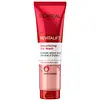What's inside
What's inside
 Key Ingredients
Key Ingredients

 Benefits
Benefits

 Concerns
Concerns

 Ingredients Side-by-side
Ingredients Side-by-side

Water
Skin ConditioningCoco-Betaine
CleansingPropylene Glycol
HumectantPEG-120 Methyl Glucose Dioleate
EmulsifyingSorbitol
HumectantGlycerin
HumectantGlycolic Acid
BufferingTriethanolamine
BufferingSodium Laureth Sulfate
CleansingSodium Chloride
MaskingDisteareth-100 Ipdi
Parfum
MaskingSalicylic Acid
MaskingCapryloyl Salicylic Acid
ExfoliatingMenthol
MaskingAloe Barbadensis Leaf Juice
Skin ConditioningDisodium EDTA
Linalool
PerfumingSteareth-100
Gel FormingCitronellol
PerfumingBenzyl Alcohol
PerfumingLimonene
PerfumingCitric Acid
BufferingPotassium Sorbate
PreservativeSodium Benzoate
MaskingWater, Coco-Betaine, Propylene Glycol, PEG-120 Methyl Glucose Dioleate, Sorbitol, Glycerin, Glycolic Acid, Triethanolamine, Sodium Laureth Sulfate, Sodium Chloride, Disteareth-100 Ipdi, Parfum, Salicylic Acid, Capryloyl Salicylic Acid, Menthol, Aloe Barbadensis Leaf Juice, Disodium EDTA, Linalool, Steareth-100, Citronellol, Benzyl Alcohol, Limonene, Citric Acid, Potassium Sorbate, Sodium Benzoate
Water
Skin ConditioningPolysorbate 20
EmulsifyingMethylpropanediol
SolventDecyl Glucoside
CleansingPEG-120 Methyl Glucose Dioleate
EmulsifyingHamamelis Virginiana Water
AstringentLactic Acid
BufferingCocamidopropyl Betaine
CleansingSodium Hydroxide
BufferingMandelic Acid
AntimicrobialSalicylic Acid
MaskingAllantoin
Skin ConditioningSodium PCA
HumectantNiacinamide
SmoothingDisodium Lauriminodipropionate Tocopheryl Phosphates
CleansingCaprylyl Glycol
EmollientSodium Lauroyl Lactylate
EmulsifyingDisodium EDTA
Phenylpropanol
MaskingFusanus Spicatus Wood Oil
MaskingEucalyptus Globulus Leaf Oil
PerfumingEugenia Caryophyllus Bud Oil
MaskingPhenoxyethanol
PreservativeSodium Chloride
MaskingDehydroacetic Acid
PreservativeSodium Benzoate
MaskingBenzoic Acid
MaskingEugenol
PerfumingWater, Polysorbate 20, Methylpropanediol, Decyl Glucoside, PEG-120 Methyl Glucose Dioleate, Hamamelis Virginiana Water, Lactic Acid, Cocamidopropyl Betaine, Sodium Hydroxide, Mandelic Acid, Salicylic Acid, Allantoin, Sodium PCA, Niacinamide, Disodium Lauriminodipropionate Tocopheryl Phosphates, Caprylyl Glycol, Sodium Lauroyl Lactylate, Disodium EDTA, Phenylpropanol, Fusanus Spicatus Wood Oil, Eucalyptus Globulus Leaf Oil, Eugenia Caryophyllus Bud Oil, Phenoxyethanol, Sodium Chloride, Dehydroacetic Acid, Sodium Benzoate, Benzoic Acid, Eugenol
 Reviews
Reviews

Ingredients Explained
These ingredients are found in both products.
Ingredients higher up in an ingredient list are typically present in a larger amount.
Disodium EDTA plays a role in making products more stable by aiding other preservatives.
It is a chelating agent, meaning it neutralizes metal ions that may be found in a product.
Disodium EDTA is a salt of edetic acid and is found to be safe in cosmetic ingredients.
Learn more about Disodium EDTAPeg-120 Methyl Glucose Dioleate is used to improve texture and stability of a product. It is sugar based and helps thicken a product.
Once applied, it also creates a thin film to trap moisture in. This helps keep your skin hydrated.
This ingredient is the polyethylene glycol ether of the diester of oleic acid and methylglucose. The 120 represents an average of 120 moles of ethylene oxide.
There is limited research on this ingredient, although it is considered safe to use in skincare products.
Learn more about PEG-120 Methyl Glucose DioleateSalicylic Acid (also known as beta hydroxy acid or BHA) is a well-known ingredient for treating skin that struggles with acne and clogged pores. It exfoliates both the skin's surface and deep within the pores to help clear out buildup, control oil, and reduce inflammation.
Unlike AHAs (alpha hydroxy acids), salicylic acid is oil-soluble. This allows it to penetrate into pores which makes it especially effective for treating blackheads and preventing future breakouts.
Salicylic acid is also known for its soothing properties. It has a similar structure to aspirin and can calm inflamed or irritated skin, making it a good option for acne-prone skin that is also sensitive.
Concentrations of 0.5-2% are recognized by the U.S. FDA as an over-the-counter topical acne product.
It can cause irritation and/or dryness if one's skin already has a compromised moisture barrier, so it's best to focus on repairing that before introducing this ingredient into your routine.
While salicylic acid does not increase sun sensitivity, it’s still important to wear sunscreen daily to protect your skin.
If you are looking for the ingredient called BHA or Butylated Hydroxyanisole, click here.
Learn more about Salicylic AcidSodium Benzoate is a preservative. It's used in both cosmetic and food products to inhibit the growth of mold and bacteria. It is typically produced synthetically.
Both the US FDA and EU Health Committee have approved the use of sodium benzoate. In the US, levels of 0.1% (of the total product) are allowed.
Sodium benzoate works as a preservative by inhibiting the growth of bacteria inside of cells. It prevents the cell from fermenting a type of sugar using an enzyme called phosphofructokinase.
It is the salt of benzoic acid. Foods containing sodium benzoate include soda, salad dressings, condiments, fruit juices, wines, and snack foods.
Studies for using ascorbic acid and sodium benzoate in cosmetics are lacking, especially in skincare routines with multiple steps.
We always recommend speaking with a professional, such as a dermatologist, if you have any concerns.
Learn more about Sodium BenzoateChances are, you eat sodium chloride every day. Sodium Chloride is also known as table salt.
This ingredient has many purposes in skincare: thickener, emulsifier, and exfoliator.
You'll most likely find this ingredient in cleansers where it is used to create a gel-like texture. As an emulsifier, it also prevents ingredients from separating.
There is much debate on whether this ingredient is comedogenic. The short answer - comedogenic ratings don't tell the whole story. Learn more about comegodenic ratings here.
The concensus about this ingredient causing acne seems to be divided. Research is needed to understand if this ingredient does cause acne.
Scrubs may use salt as the primary exfoliating ingredient.
Learn more about Sodium ChlorideWater. It's the most common cosmetic ingredient of all. You'll usually see it at the top of ingredient lists, meaning that it makes up the largest part of the product.
So why is it so popular? Water most often acts as a solvent - this means that it helps dissolve other ingredients into the formulation.
You'll also recognize water as that liquid we all need to stay alive. If you see this, drink a glass of water. Stay hydrated!
Learn more about Water